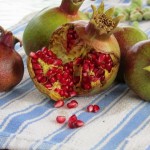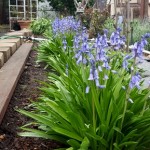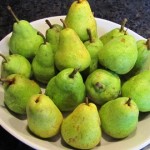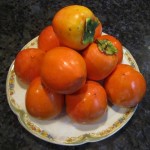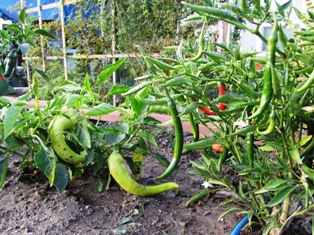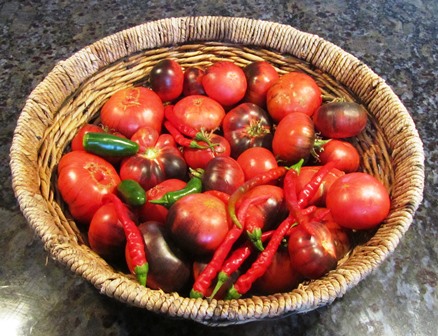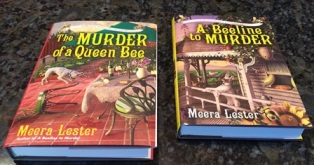A CHORES LIST FOR THE AUTUMN GARDEN
Each year on the first day of autumn here on the Henny Penny Farmette, I take stock of my fruit trees and vegetable and flower gardens.
The Old Farmer’s Almanac points to mid-October 2019 for early rain in Northern California, so there’s much for me to do over the next two or three weeks.
- Nothing says “autumn” like ripe pomegranates
My chores list includes the following items. They’re roughly the same from year to year.
1. Gather seeds from self-seeding or heirloom, open-pollinated plants (flowers and vegetables) for next year’s garden. Dry seeds and store them for planting next spring.
2. Sow spring-blooming bulbs (such as daffodils, tulips, hyacinths, ranunculus, crocus, and buttercups available in garden centers now).
3. Turn soil and prepare beds for the cool-season vegetable garden (broccoli, cabbage, beets, and parsnips).
4. Inspect and divide perennials.
5. Harvest olives and preserve them.
6. Pick late summer pears and ripe pomegranates. The leathery covering of pomegranates already may be splitting open and showing ruby red seeds. The juice of the seeds makes a wonderful jelly.
7. Check persimmons for ripeness. Pick if they’re ready. They might need another month.
8. Harvest and store pumpkins and butternut squash. Peel, remove seeds, and cut the flesh into squares for freezing.
9. Compost old garden vines and vegetable plants that are done bearing for the season. Check tomato plants infected with bacterial or fungal diseases and do NOT add any of these to the compost pile.
10. Begin the process of cleaning and storing gardening items not required over the winter.
11. Sow spring-blooming wildflowers in prepared beds.
12. Schedule time to prune back crop-bearing fruit trees (like apricot, peach, and plum).
I actually look forward to those chores. They’re part of the natural rhythm of farmette life. With a list and plan to get everything done, I won’t be caught by surprise when the weather turns cold, dark, and rainy.
________________________________________________________________________________________________
If you enjoy reading about farming, country living, keeping of bees and chickens, and gardening, check out my Henny Penny Farmette series of cozy mysteries. They’re chocked full of ideas, tips, and delicious recipes for country living.
Also, take a look at my numerous self-help and wellness books. All are available at Amazon.com, Barnes & Noble.com, Walmart.com, and other online and traditional bookstores everywhere.

More than 150 rituals for sound mind, strong body, and meaningful connections to the people around you
Planting the Spring Garden
Winter brought us lots of rain and now the ground has warmed up and is ready to receive the heirloom seedlings of our favorite vegetables and herbs.
Tomatoes won’t set fruit until the nighttime temps hover around 55 degrees Fahrenheit, but I tucked in several seedlings of heirloom varieties (Bradley, Cherokee Purple, and Red Beefsteak). Victory Seeds offers a nice selection of open-pollinated, non GMO, rare heirloom seeds for a variety of tomatoes. See, http://www.victoryseeds.com/tomato.html
While I was digging, my neighbor’s bees decided to swarm. So I stopped gardening to check on my own bees. They’ve been humming like a truck engine, and there has been a lot of bee traffic. Concerned that they might swarm, I set aside my shovel and got out the swarm catcher, the lemon oil, and the hand pump sprayer. I positioned the swarm catcher in a tree across the yard, sprayed the tree with lemon oil, and went back to gardening.
I’ve readied a patch of ground for the sweet corn, squash, peppers, and beans. Also, in a large-size planter pot, I’ve tucked in flat Italian parsley, Italian oregano, dill, chives, and sweet basil. The patio pot will remain near the kitchen slider in full sun so I have culinary herbs at the ready when I need them.
The early sweet peas are taking off now and the garlic and onions I put in the garden last fall are about a foot high. The vegetables and herbs I plant now will provide me with plenty of nutritious offerings right up until late fall–one of the many reasons to plant a garden in spring.
Enjoy this blog? Check out my Henny Penny Farmette novels, available online and in traditional bookstores everywhere.
Home-cooked Meals Made Easy for Harried Holiday Shoppers
Family and friends may love the hustle and bustle of holiday activities but often are too tired at the end of the day to cook. There’s a simple solution. Before leaving the house, someone needs to assemble a stew or meal that simmers all day in a slow cooker.

A hearty bean and beef stew is garnished with a dash of extra virgin olive oil, Italian parsley, and coarsely ground black pepper
The process is simple. Choose your meal, put the ingredients in a slow cooker, turn it on, and forget about it until you are ready to feed your gang at the end of the day.
Slow cookers are terrific tools for making tasty stews like apple chicken, Mexican pork and hominy, and red beans with Cajun sausages. Or, make a corned beef and cabbage dish with carrots and potatoes. Beef stroganoff, pepper steak, and even clam chowder or a fish stew taste sublime when cooked slowly for several hours.
Serve your hot meal alongside a simple salad. Choose perhaps broccoli slaw with chopped apples and pears, segments of seedless tangerines, and a handful of sliced almonds. Drizzle or spritz with Asian Sesame Ginger dressing. Put out slices of French bread and possibly a platter of cheese.
Right before serving the meal, sprinkle the hot food with some fresh herbs, a dash of olive oil, some shaved cheese, or coarsely ground black pepper. What could be easier?
For more delicious farmhouse recipes, tips for keeping honeybees and chickens, growing heirloom vegetables, and tending fruit trees, check out my latest book, A BEELINE TO MURDER.
Released in hardcover, the book makes a great gift for holidays, birthdays, and other celebratory events. Available online and a brick-and-mortar bookstores everywhere. See, http://tinyurl.com/p8d6owd

The first cozy mystery in the Henny Penny Farmette mystery series by Meera Lester, from Kensington Books
Growing Greens
Early spring on the Henny Penny Farmette offers the perfect amount of sunshine, cool weather, and rain that lettuce and salad greens love. Lettuce is a cool-season crop and bolts in the heat, going to seed in the hot days of summer. Of course, from bolting comes seeds that you can harvest, dry, and plant another day.
Lettuce doesn’t demand much space to it can be tucked in around your garden almost anywhere. It likes nitrogen-rich soil that drains well and also retains moisture–in short, a rich humus type of soil. Lettuce plants have rather shallow roots and is almost 90 percent water. That means it needs lots of water (but again, good drainage).
Romain and Butterhead (or Boston) lettuce leaves are rich in nutrients whereas iceberg lettuce (that has leaves that are crisp and formed like cabbage) is the least nutritious. It lacks the abundant amount of Vitamins A and B that are found in other cultivars of lettuce (and there are many).
Plant lettuce seeds 1/4 inch deep and space your rows 1 1/2 feet apart. Bear in mind, that you will get a lot of lettuce from a single seed pack–approximately 80 heads or 50 pounds of leaves in a 100-foot-long row.
Successive plantings over smaller amounts will enable you to have greens for salads and sandwiches right up to the warm days of summer. Even in summer, if you plant heat-resistant types of lettuce and plant them in the shade, giving them plenty of water, you can eat lettuce throughout the summer. Then in midsummer, plant head lettuces to harvest until the first frost.
Try growing some greens for fresh salads. Most lettuce will keep up to around ten days to two weeks in the refrigerator.
 Facebook
Facebook Goodreads
Goodreads LinkedIn
LinkedIn Meera Lester
Meera Lester Twitter
Twitter





